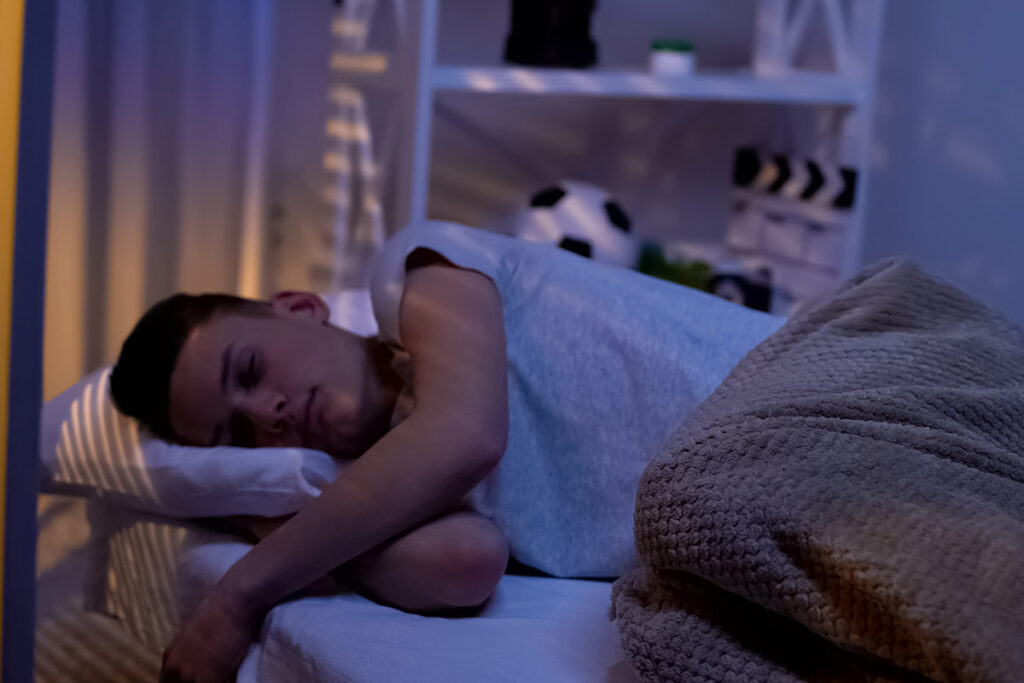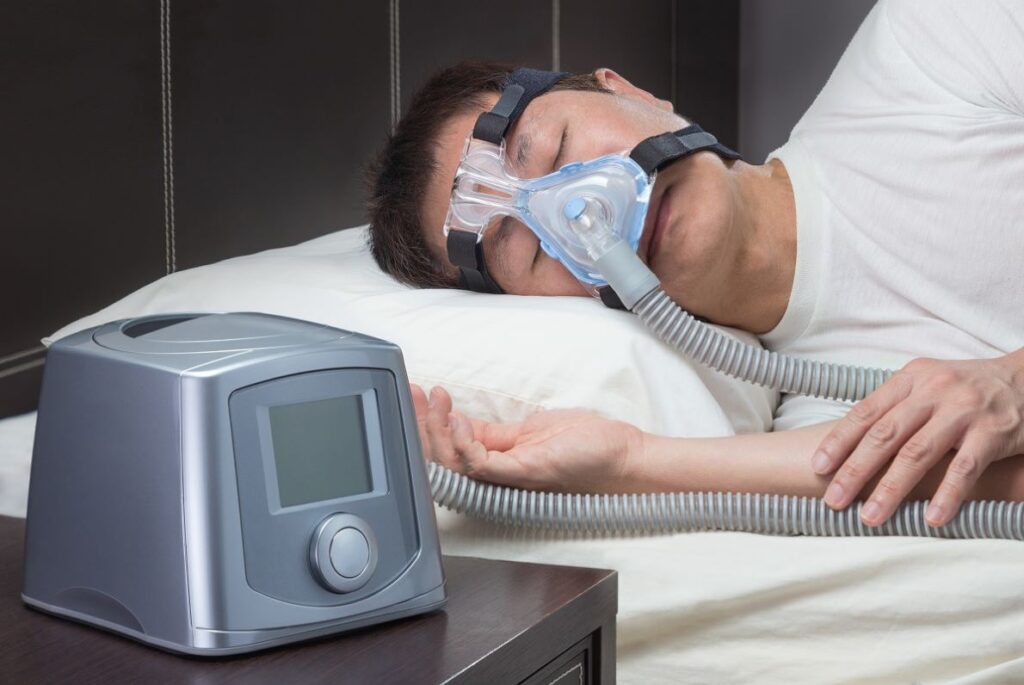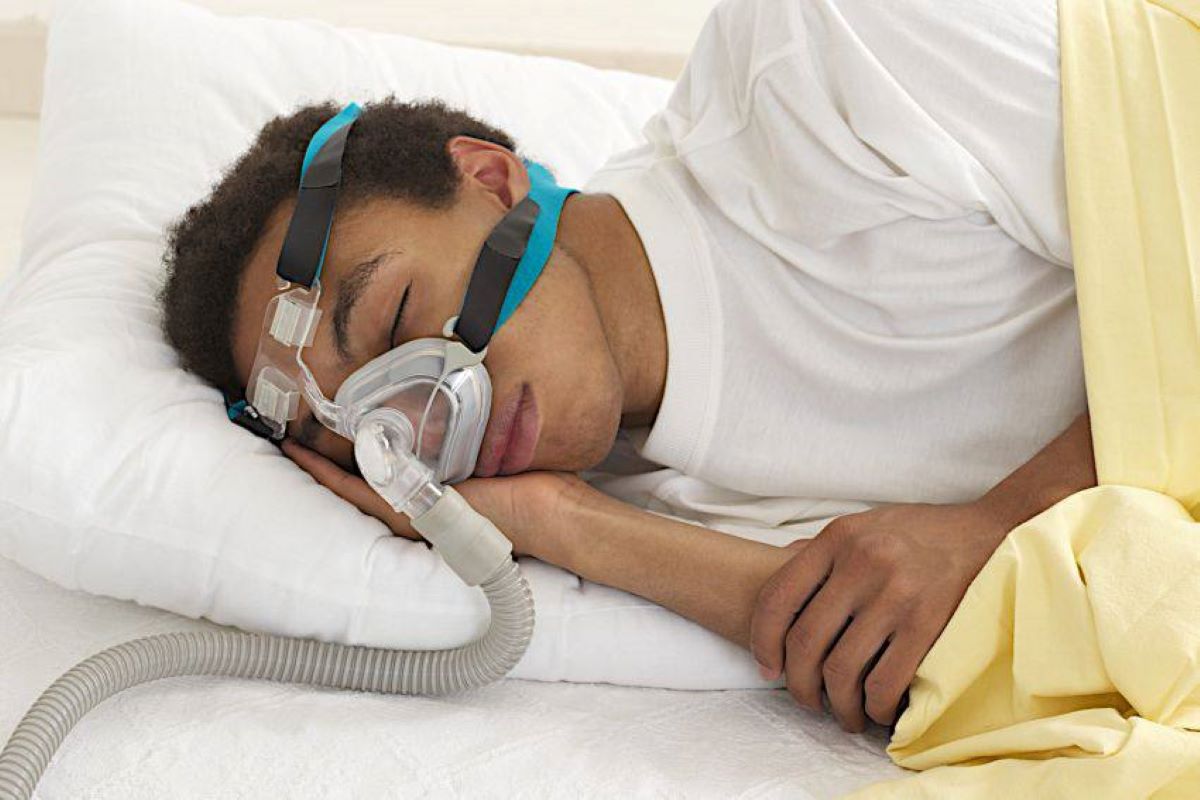Understanding Sleep Studies
A sleep study is a detailed examination that looks at how your body functions while you sleep. It tracks various bodily processes to help doctors understand sleep disorders and create effective treatment plans for patients in Sydney.
Types of Sleep Studies
There are two main types of sleep studies:
- Polysomnography: This is the most comprehensive type of sleep study. It takes place in a specialised clinic where trained professionals monitor you overnight. During this study, various aspects of your sleep, including brain activity and breathing patterns, are recorded.
- Home Sleep Studies: These studies offer a more convenient option as they can be done at home. Using portable devices, healthcare providers can monitor specific factors like breathing patterns and oxygen levels while you sleep. Home sleep studies are particularly useful for diagnosing conditions such as sleep apnoea.
How Sleep Studies Work
Regardless of the type of study, both polysomnography and home sleep studies rely on similar principles:
- Sensors: Adhesive sensors are placed on different parts of your body to collect data during sleep.
- Parameters Monitored: The sensors track various physiological measurements such as brain activity (EEG), heart rhythm (ECG), blood oxygen levels (oximetry), airflow (respiratory sensors), and leg movements (movement detectors).
- Data Analysis: After the study is complete, the collected data is analysed by sleep specialists who use it to identify any abnormalities or disruptions in your sleep patterns.
Why Are Sleep Studies Important?
Sleep Study Sydney plays a crucial role in diagnosing and treating sleep disorders because it provides objective evidence about what happens during your sleep, such as:
- Identifying specific sleep stages
- Assessing the severity of breathing problems
- Understanding how lifestyle factors impact your overall sleep quality
By combining this information with other clinical assessments, doctors can develop personalised treatment plans that address the underlying causes of your sleep issues.
If you’re experiencing persistent difficulties with sleeping or suspect you may have a related condition, consult an experienced healthcare professional who can guide you through the process and determine if further evaluation via a Sleep Study Sydney is necessary.
Common Sleep Disorders Diagnosed
Sleep studies reveal a range of disorders that significantly impact your daily functioning and long-term health outcomes. Obstructive sleep apnea is the most frequently diagnosed condition, affecting millions of Australians who experience repeated breathing interruptions during sleep. This disorder occurs when throat muscles relax excessively, blocking your airway and causing oxygen levels to drop throughout the night.
Other Common Sleep Disorders
- Insomnia: Insomnia diagnosis through polysomnography helps distinguish between different subtypes of sleep initiation and maintenance difficulties. You might struggle with falling asleep, staying asleep, or experiencing non-restorative sleep despite adequate time in bed. Sleep studies capture the underlying physiological patterns that contribute to these symptoms.
- Periodic Limb Movement Disorder: Periodic limb movement disorder presents as repetitive leg movements during sleep, often accompanied by brief arousals that fragment your sleep architecture. These involuntary movements can occur hundreds of times per night without your awareness.
Health Consequences of Untreated Sleep Disorders
The health consequences of untreated sleep disorders extend beyond daytime fatigue:
- Cardiovascular complications including hypertension and irregular heart rhythms
- Metabolic disruptions affecting blood sugar regulation and weight management
- Cognitive impairment impacting memory, concentration, and decision-making abilities
- Increased accident risk due to excessive daytime sleepiness
- Mental health challenges including depression and anxiety disorders
Early identification through comprehensive sleep studies enables targeted treatment approaches that can dramatically improve your quality of life and reduce associated health risks.
The Patient Pathway in Sydney
The journey to sleep disorder diagnosis in Sydney begins with your GP referral for sleep study. Your general practitioner evaluates your sleep-related symptoms and medical history before determining whether specialist intervention is necessary. This initial assessment considers factors such as excessive daytime sleepiness, witnessed breathing interruptions, or chronic insomnia patterns.
Following your GP’s referral, you’ll receive a Sleep specialist consultation Sydney appointment. Sleep physicians conduct comprehensive evaluations that include detailed sleep histories, physical examinations, and assessment of underlying medical conditions that may contribute to sleep disturbances.
Sydney’s healthcare system employs an integrative approach that streamlines patient care through coordinated pathways. Air Liquide Healthcare exemplifies this model as Australia’s largest facilitator of home sleep apnea studies and therapy. Their end-to-end solution encompasses:
- Initial diagnostic assessment coordination
- Home-based sleep study facilitation
- Treatment pathway management
- Ongoing therapy support and monitoring
This integrative model connects you with validated Sleep Physicians who oversee your entire treatment journey. The coordinated care approach ensures seamless communication between your GP, sleep specialist, and treatment providers. Air Liquide Healthcare’s partnerships with CPAP equipment manufacturers and extensive coverage through sleep brands like SNORE Australia, Healthy Sleep Solutions, and Sleep Disorder Australia (SDCA) create a comprehensive network supporting your sleep health needs throughout Sydney.
Preparing for a Sleep Study
Proper preparation significantly impacts the accuracy of your sleep study results. You need to follow specific guidelines to ensure the monitoring equipment captures reliable data throughout the night.
Pre-Study Dietary Restrictions
Your preparation begins 24 hours before the study. Avoid these substances that can interfere with natural sleep patterns:
- Caffeine – No coffee, tea, chocolate, or energy drinks after 2 PM
- Alcohol – Complete abstinence for 24 hours prior
- Daytime naps – Stay awake during the day to ensure you’re naturally tired
Optimising Sensor Placement Requirements
The adhesive sensors used during polysomnography require direct skin contact for accurate readings. You must prepare your body accordingly:
- Hair products – Wash your hair with regular shampoo only; avoid conditioners, gels, or styling products
- Nail polish – Remove all polish from fingernails and toenails as pulse oximetry sensors need clear nail beds
- Skin preparations – Avoid moisturisers, oils, or makeup on areas where sensors will be placed
- Facial hair – Men should consider shaving areas where chin and cheek sensors attach
Medication Considerations
Continue taking prescribed medications unless your sleep physician specifically advises otherwise. Bring a complete list of current medications, including dosages and timing. Some sleep medications may need adjustment, but never stop prescribed treatments without medical consultation.
These sleep study preparation tips ensure technicians can properly attach monitoring equipment and obtain the most accurate physiological data possible. Check out more about Sleep Study Cost in Australia: What to Expect and How to Budget.
What Happens During the Sleep Study Night?
The overnight monitoring procedure begins when you arrive at the sleep clinic or prepare your home-based equipment. Understanding what happens during these crucial hours helps reduce anxiety and ensures you get the most accurate results from your study.
In-Clinic Sleep Study Experience
Your patient experience during polysomnography starts with a technician explaining the sensor attachment process. The technician will apply approximately 20-25 sensors to specific locations on your body:
- EEG electrodes placed on your scalp to monitor brain waves
- ECG leads positioned on your chest to track heart rhythm
- Respiratory belts around your chest and abdomen to measure breathing effort
- Nasal cannula to detect airflow
- Pulse oximeter on your finger to monitor oxygen levels
- EMG sensors on your chin and legs to track muscle activity
The attachment process typically takes 30-45 minutes. You’ll then settle into a private bedroom designed to replicate a comfortable home environment. The room features:
- Adjustable lighting and temperature controls
- Comfortable bed with quality linens
- Private bathroom facilities
- Continuous video and audio monitoring systems
Home-Based Study Setup
For home studies, you’ll receive detailed instructions on self-applying the portable monitoring device. The simplified setup includes fewer sensors but captures essential data including breathing patterns, oxygen levels, and heart rate. You maintain your normal bedtime routine in familiar surroundings.

Monitoring Throughout the Night
Sleep technicians observe your sleep patterns remotely through sophisticated monitoring systems. They can adjust equipment settings if needed and ensure continuous data collection. The monitoring captures every sleep stage transition, breathing irregularity, and movement pattern.
You can communicate with technicians via intercom systems in clinic settings if you experience discomfort or need assistance. The goal remains achieving natural sleep whilst gathering comprehensive physiological data for accurate diagnosis.
Home-Based Sleep Studies in Sydney
Portable sleep monitors Sydney offer a convenient alternative to traditional clinic-based testing, allowing you to undergo sleep assessment in your own bedroom. These compact devices record the same essential data as clinic studies whilst you sleep in familiar surroundings.
Benefits of Home Studies
The benefits of home studies extend beyond simple convenience:
- Natural sleep environment – You maintain your regular bedtime routine and sleep in your own bed
- Cost-effective solution – Home testing typically costs less than overnight clinic stays
- Reduced waiting times – Faster access to diagnosis compared to clinic bookings
- Family-friendly – No disruption to family schedules or childcare arrangements
- Comfort factors – Your own pillows, temperature preferences, and familiar sounds
Suitable Candidates for Home Testing
Home-based studies work best for patients with suspected obstructive sleep apnoea who don’t have complex medical conditions. You’re likely suitable if you:
- Experience loud snoring with witnessed breathing pauses
- Have daytime fatigue without other significant health issues
- Don’t require complex monitoring for multiple sleep disorders
- Can follow simple device setup instructions
Air Liquide Healthcare facilitates Australia’s largest network of home sleep studies, providing validated testing through their integrative approach with Sleep Physicians. Their portable devices capture breathing patterns, oxygen levels, and movement data whilst you sleep naturally at home.
Post-Sleep Study Analysis and Results
Your sleep data analysis Sydney journey begins once technicians collect your overnight recordings. Sleep specialists examine multiple physiological parameters captured during your study, creating a comprehensive picture of your sleep architecture and breathing patterns.
The analysis process focuses on several key areas:
- Sleep stage classification – Specialists identify REM and non-REM sleep phases using EEG patterns, determining how much time you spend in each stage
- Arousal detection – Brief awakenings or sleep disruptions are counted and categorised by cause
- Respiratory event scoring – Apnoeas, hypopnoeas, and oxygen desaturation episodes are measured and indexed
- Movement analysis – Leg movements and position changes are documented
Interpreting polysomnography results requires expertise in recognising abnormal patterns. Sleep physicians examine your Apnoea-Hypopnoea Index (AHI), which measures breathing interruptions per hour. An AHI below 5 is normal, whilst scores above 30 indicate severe sleep apnoea.
Your consultation with sleep specialists typically occurs within two weeks of your study. During this appointment, you’ll receive detailed explanations of your results, including severity classifications and specific abnormalities detected. Sleep physicians use standardised criteria to diagnose conditions like obstructive sleep apnoea, periodic limb movement disorder, or REM sleep behaviour disorder.
The specialist will correlate your symptoms with objective findings, ensuring accurate diagnosis and appropriate treatment recommendations tailored to your specific sleep disorder profile.
Treatment Options Following Diagnosis
Your sleep study results guide the development of a personalised treatment plan tailored to your specific condition and severity level. Sydney’s sleep medicine facilities offer comprehensive treatment pathways that address both the immediate symptoms and long-term management of sleep disorders.
CPAP Therapy Initiation Sydney
CPAP therapy initiation Sydney represents the gold standard treatment for moderate to severe obstructive sleep apnoea. Local sleep centres provide structured programs that include:
- Initial equipment fitting with trained technicians who ensure proper mask selection and sizing
- Pressure titration studies to determine optimal therapeutic settings for your individual needs
- Comprehensive education sessions covering equipment maintenance, troubleshooting, and compliance tracking
- Follow-up appointments within the first few weeks to address any comfort or adjustment issues
Air Liquide Healthcare’s network across Sydney facilitates seamless CPAP therapy initiation through their partnerships with leading equipment manufacturers. You receive ongoing support through regular check-ups and therapy guidance to maximise treatment effectiveness.
Lifestyle Changes for Sleep Apnoea
Lifestyle changes for sleep apnoea play a crucial role in managing mild cases and enhancing the effectiveness of other treatments:
- Weight management through structured diet and exercise programs
- Sleep position training to reduce airway obstruction during sleep
- Alcohol and smoking cessation to improve airway muscle tone
- Sleep hygiene optimisation including consistent bedtime routines and bedroom environment modifications
These modifications often complement primary treatments and can significantly improve your sleep quality and daytime alertness.
Financial Considerations and Coverage
Understanding the costs associated with sleep studies and subsequent treatments helps you plan your healthcare journey effectively. Medicare bulk-billing sleep studies Sydney facilities provide accessible diagnostic options for eligible patients, ensuring financial barriers don’t prevent proper evaluation of your sleep concerns.
Medicare Coverage Criteria
Medicare covers sleep studies when specific Medical Benefits Schedule (MBS) guidelines are met. You’ll need a referral from your GP or specialist, and the study must be conducted at an approved facility. The coverage typically includes:
- Polysomnography for suspected obstructive sleep apnoea
- Home-based sleep studies using validated portable devices
- Follow-up consultations with sleep specialists
Your eligibility depends on presenting symptoms such as witnessed breathing interruptions, excessive daytime sleepiness, or cardiovascular complications potentially linked to sleep disorders.
Private Insurance Options
Private health insurance CPAP coverage varies significantly between providers and policy levels. Many insurers offer benefits for CPAP equipment under their extras or hospital cover packages. You should verify:
- Annual limits for respiratory equipment
- Waiting periods before claiming benefits
- Approved supplier networks
- Coverage for ongoing consumables like masks and tubing
Air Liquide Healthcare works with major private insurers to streamline your claims process, often providing direct billing arrangements that reduce your out-of-pocket expenses for both diagnostic testing and therapeutic equipment.

Additional Diagnostic Tools Beyond Polysomnography
Actigraphy is a valuable addition to traditional sleep studies, providing unique insights into your sleep patterns through longer monitoring periods. This non-invasive diagnostic tool uses a small device, similar to a watch, that tracks your movement and light exposure over several weeks, giving sleep specialists detailed information about your natural sleep-wake cycles.
Benefits of Actigraphy Testing for Sydney Patients
The benefits of actigraphy testing for Sydney patients include:
- Longer monitoring periods – usually 7-14 days instead of just one night
- Normal sleep environment – you continue your usual routine at home
- Circadian rhythm assessment – identifies disruptions in your body’s internal clock
- Activity pattern analysis – shows how daily activities impact your sleep quality
Sleep doctors particularly value actigraphy for diagnosing chronic insomnia and circadian rhythm disorders such as delayed sleep phase syndrome or shift work sleep disorder. The device captures subtle patterns that might be missed during a single night’s observation, especially when your sleep problems are occasional or linked to lifestyle factors.
How Actigraphy Works
You’ll wear the actigraph continuously, taking it off only when showering. The device automatically records your movements, sleep efficiency, and wake periods, creating a detailed picture of your sleep habits. This information is especially helpful when combined with traditional polysomnography results, giving your sleep specialist a complete understanding of your sleep health for more targeted treatment recommendations.

